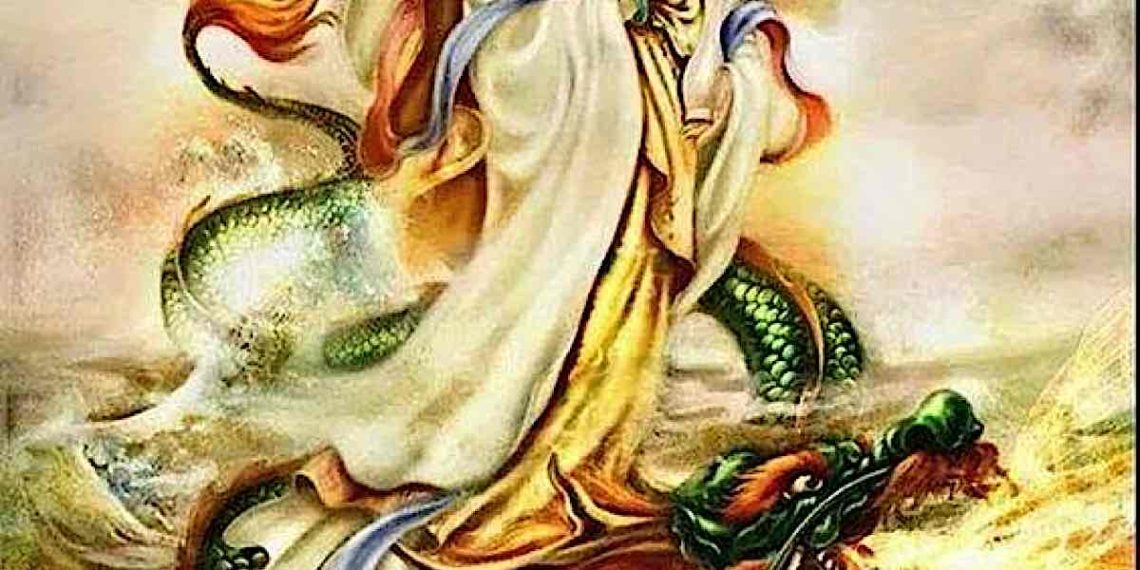March 21 2022 is Guanyin’s Birthday!
Guanyin is often referred to as the “most widely beloved Buddhist Divinity.”[2] Why? Because Her love is unconditional, all-embracing — with all 1000 arms! — and She will never cease her merciful activity until all beings are rescued from Samsara’s suffering.
Guanshiyin Bodhisattva’s popularity and forms eclipse any dualistic attempts to define Her/Him. Venerable Master Hsuan Hua explains why it is so difficult to define the embodiment of compassion:
“In Buddhism, he appears as a Bodhisattva; in other religions he often appears clad in white robes. In Christianity, he is the Holy Mother; he appears as the Holy Mother to teach and transform a certain category of beings … He fills empty space and pervades the Dharma Realm; he is in every place and yet not in any place. He appears according to what kind of body is needed to save each particular category of beings… Guanshiyin Bodhisattva is not necessarily male or female… These are the endless miraculous functions and inconceivable states of Guanshiyin Bodhisattva.”[5]
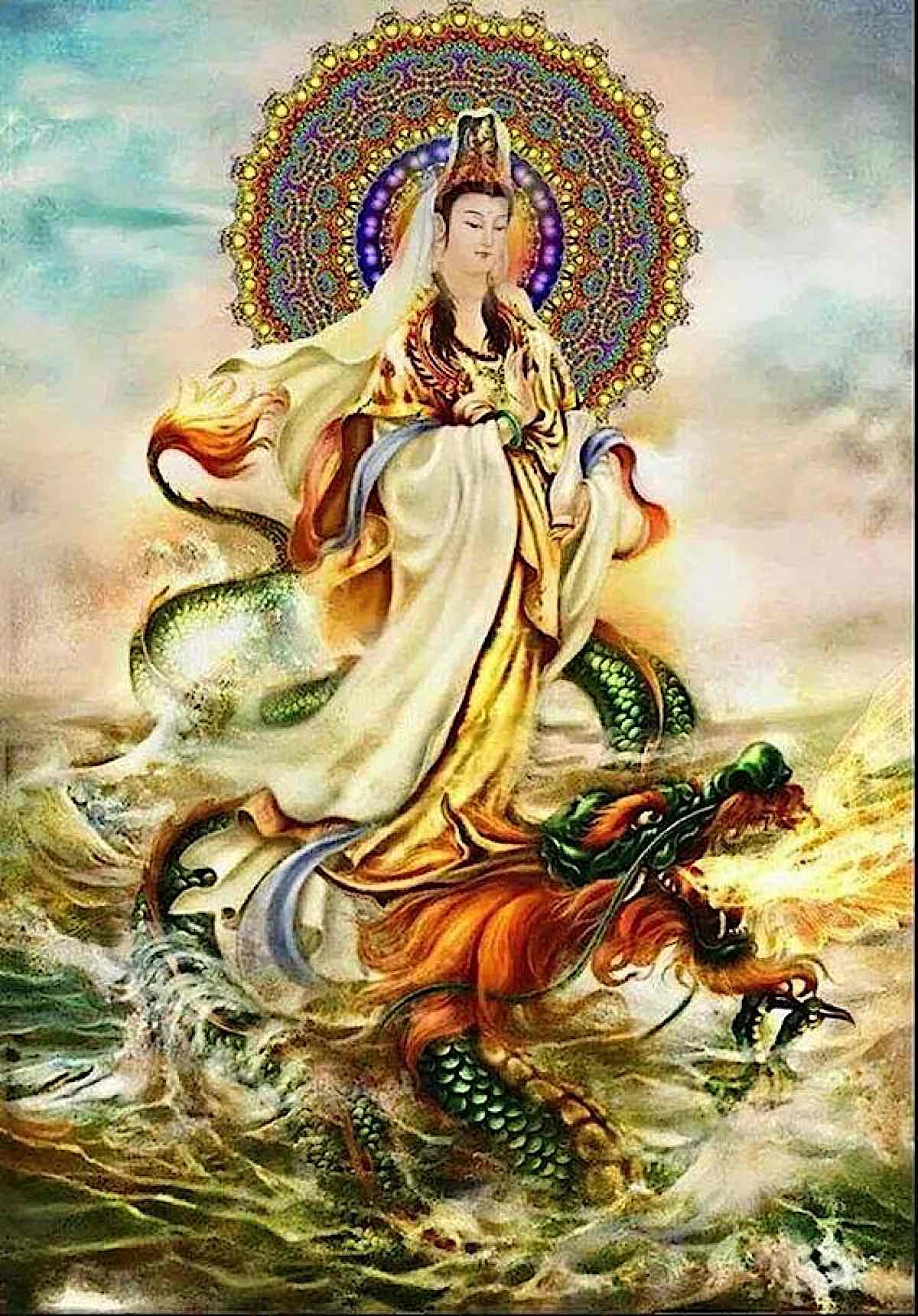
Guanyin manifests in 33 forms according to Lotus Sutra, plus countless others. She can manifest in whatever form a person needs to deliver them to safety, or to bring them wisdom. She can even manifest as gods (such as Brahma) or wrathful deities (such as Mahakala) or as incarnations of humans. Here, we see her in her most iconic form.
The “Pop Star” of Buddhism
Buddhism is not about personalities, ego, and popularity — but if there was a “popularity contest” — Guanyin (Kuan yin, Guanshiyin, Kuanyin, Avalokiteshvara, Kannon) would undoubtedly have the biggest devotional fan base.
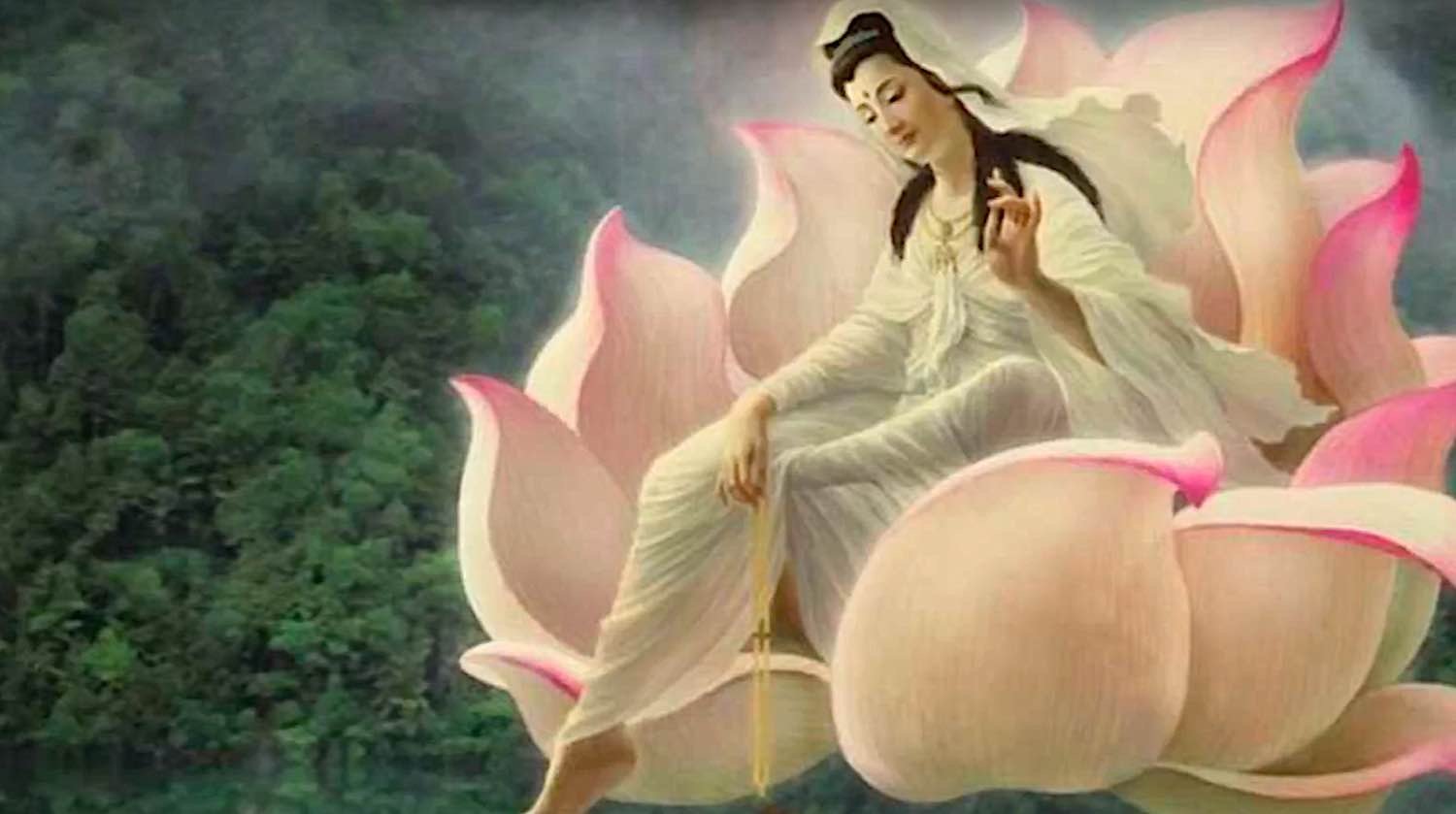
Guan Yin on a lotus.
It’s a terrible metaphor, but it illustrates Her/His unrivaled compassionate activity in our suffering world. Guanyin’s hit song would be the Heart Sutra. And, just to demonstrate her all-inclusive compassionate nature, she appears on stage as female or male (hence the Her/His above), and countless forms: Holy Savior, compassionate Bodhisattva, active Protector, a 1000-armed miracle — and even ferocious or wrathful. Perhaps the most famous manifestation is 1000-armed Guanyin — the many arms symbolic of her loving, compassionate, saving activity:
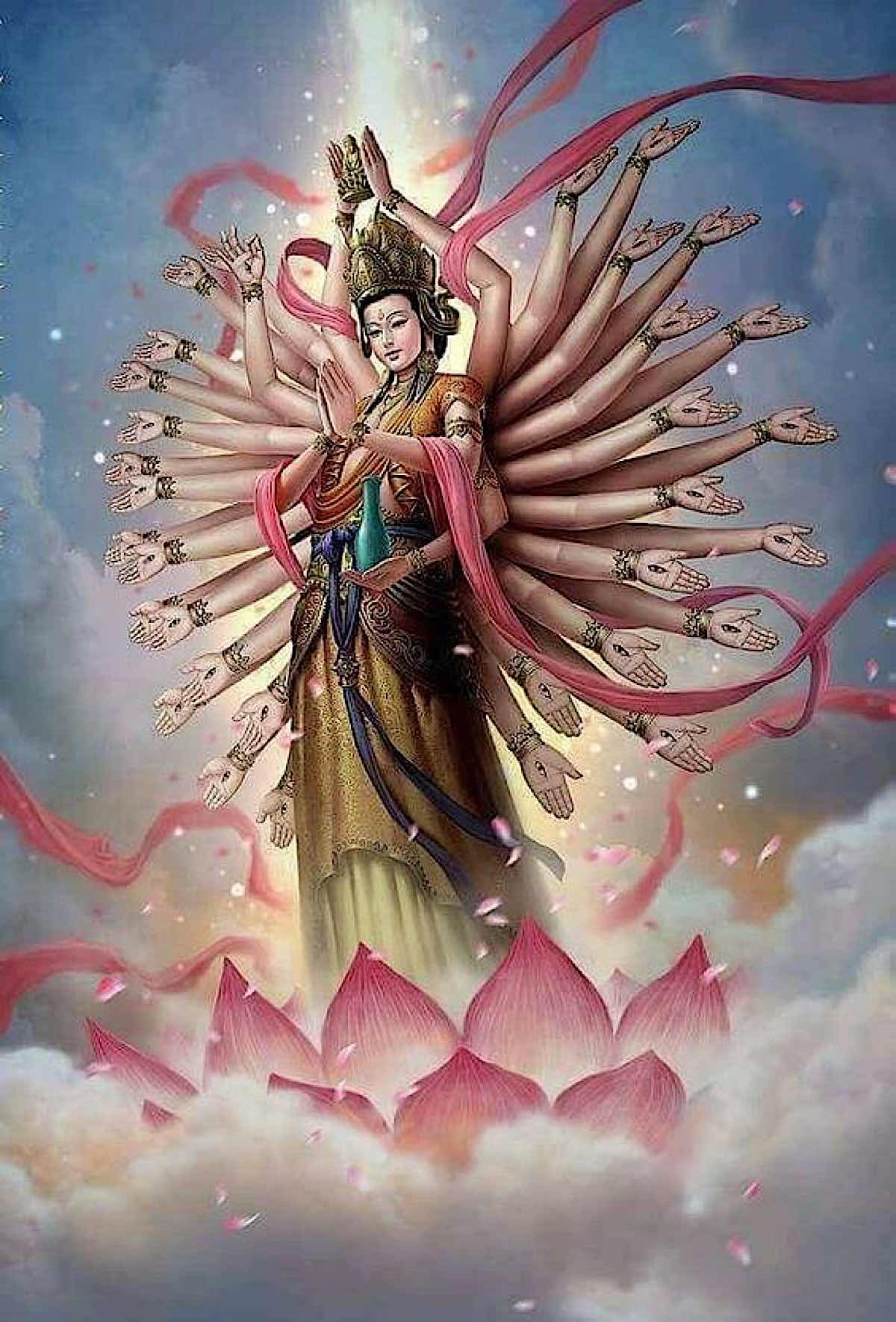
1000-armed Guan shi Yin Avalokteshvara. She manifests with 1000 arms to symbolized her vast and limitless compassionate activities.
No representation of Enlightenment is more loving or compassionate. No Bodhisattva is more active. The great Mahayana Vehicle — that rescue vehicle that hopes to rescue all suffering beings (not just a few) — is exemplified in Avalokiteshvara Guanyin. The two most important concepts in Mahayana Buddhism are Compassion and Wisdom — and Guanyin embraces both.
All-embracing love
Robert Thurman explains why Avalokiteshvara is so popular around the world: “…in a sense, Avalokiteshvara is even more than a buddha. After attaining buddhahood, he voluntarily returned to the way of a bodhisattva in order to lead all beings to buddhahood.” [1]

33 meter statue of Guanyin on Mt. Putuo, China, a sacred place for her practice.
Symbolically, Guanyin Avalokiteshvara appears as both male and female: male representing compassion and female representing wisdom. Her power is so all-embracing and loving, that she manifests in endless ways to help us.
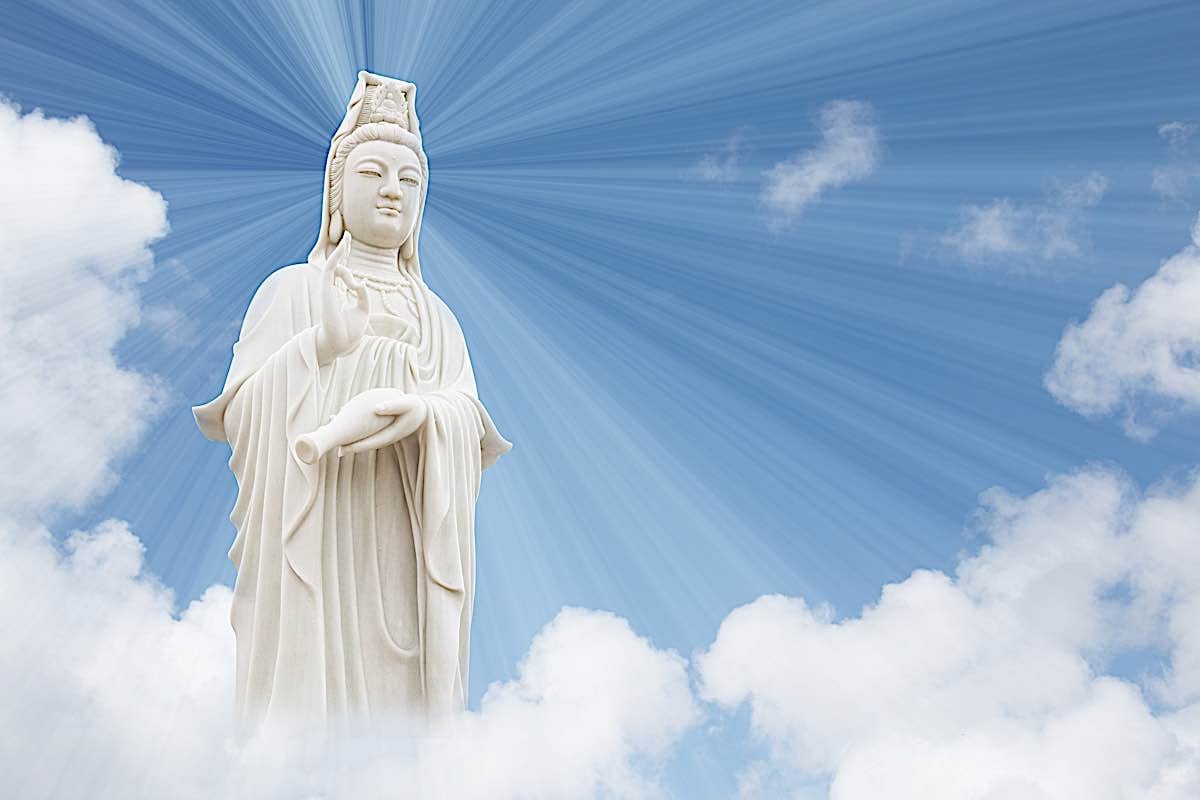
Guanyin Bodhisattva — Kuan Yin or Avalokiteshvara or Chenrezig — is synonomous with Metta (loving kindness) and Karuna (compassion.)
Guanyin Avalokeshvara does not ask for devotion, nor require it, but her all-embracing Metta and Karuna (Love and Compassion) make her among the most loved face of Enlightenment. Whoever simply looks at her loving, gentle face — even a non-Buddhist — feels instant love, warmth, and peace. Simply that. Gaze upon the loving face of any of her peaceful representations. It’s a proven method for relaxation and stress-reduction. [See this feature Avalokiteshvara Compassion Practices Enhance Treatment of Anxiety and Depression: Science>>]
Even her epitaphs are soothing and inspiring:
- Goddess of Mercy (A title given Her by Christian Jesuit missionaries in China, who responded to her loving savior nature.)
- She Who Hears the Cries of the World (More or less a translation of Her name.)
- The Lord Who Looks in Every Direction
- Bodhisattva of Compassion
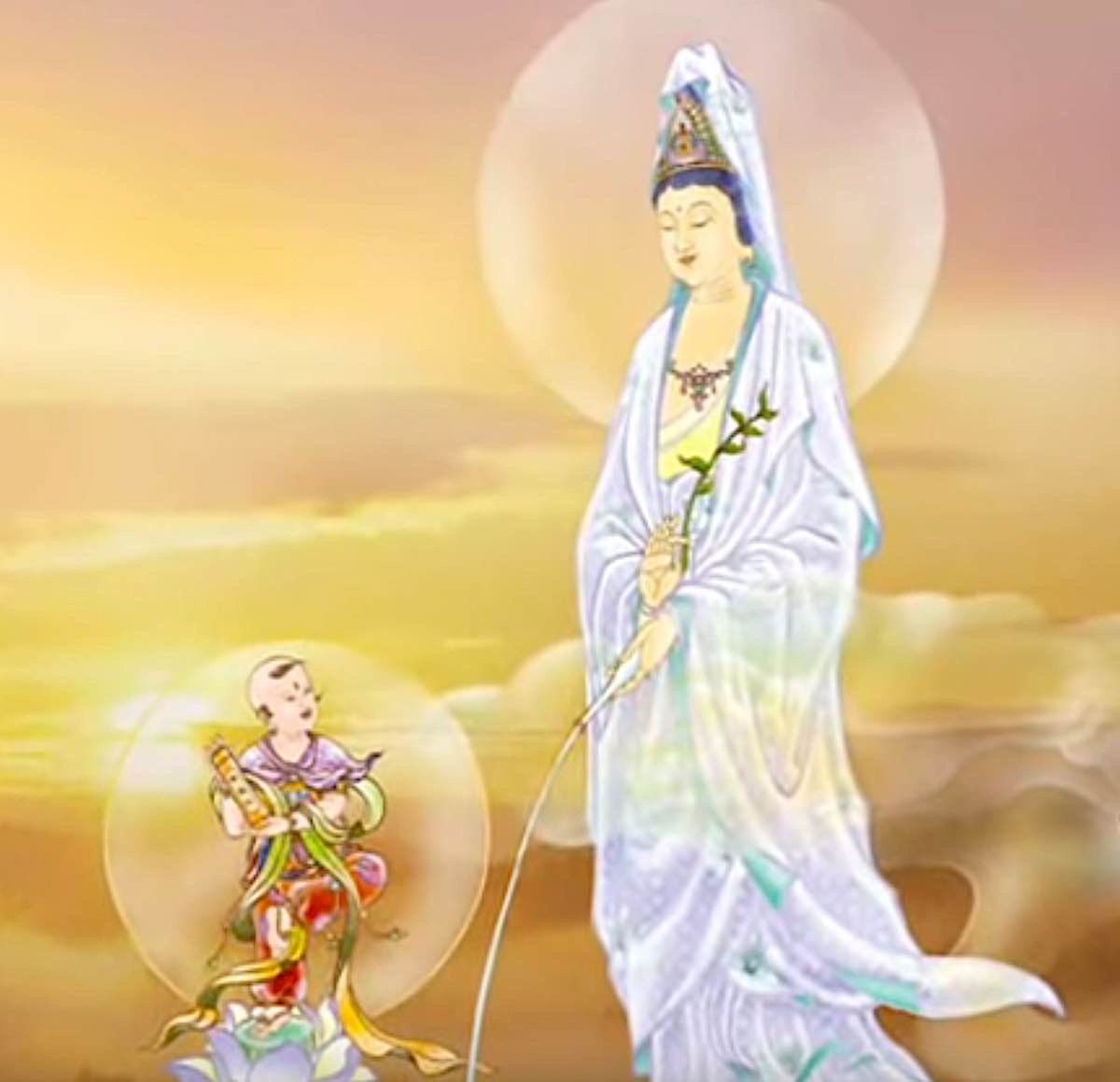
So perfect is Guanyin that she also arises in the Daoist pantheon and a key figure of worship. How, then, can we define the undefinable? Venerable Hsuan Hua, in a Dharma talk, explains:
” Guanshiyin Bodhisattva already became a Buddha a long time ago, by the name of Right Dharma Brightness. He simply appears as a Bodhisattva in order to teach and transform living beings… Guanshiyin Bodhisattva uses kindness, compassion, joy, and giving to save all living beings. He saves beings from the seven difficulties, responds to two kinds of seeking, has fourteen kinds of fearlessness, speaks Dharma in nineteen ways, and has thirty-two response bodies.”
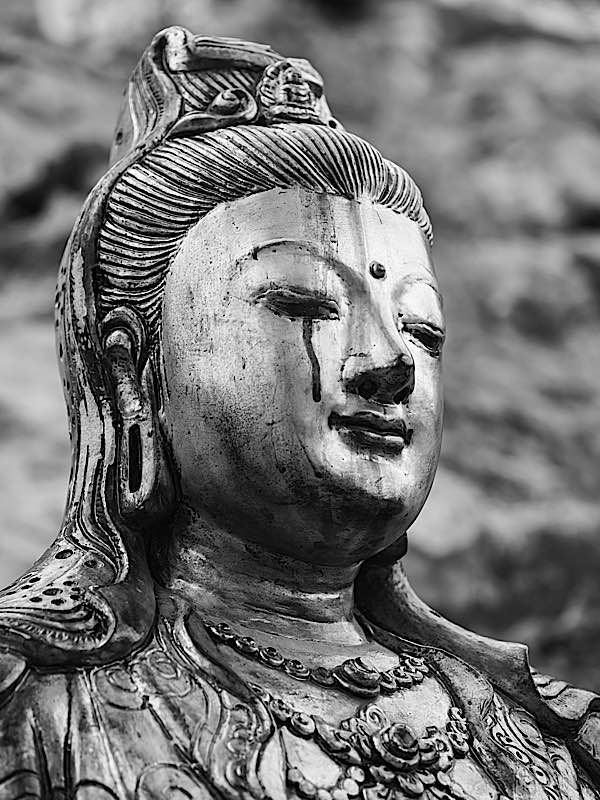
The weeping Guan Yin. Guan Yin’s name literally translates (in some versions) as “She who hears the cries of the world.” The goddess of mercy and compassion is none other than Avalokiteshvara.
Guanyin Appears in Countless Forms
In the Lotus Sutra, Avalokiteshvara is described as the Bodhisattva who can take any form, including all Gods, Buddhas, and Heavenly Beings, or even humans or animals. Of the thirty-three manifestations of Guanyin listed in the Lotus Sutra, seven are female. From the sutra:
“The Buddha said to Bodhisattva Inexhaustible Intent: “Good man, if there are living beings in the land who need someone in the body of a Buddha in order to be saved, Bodhisattva Perceiver of the World’s Sounds immediately manifests himself in a Buddha body and preaches the Law for them. If they need someone in a pratyekabuddha’s body in order to be saved, immediately he manifests a pratyekabuddha’s body and preaches the Law to them. If the need a voice-hearer to be saved, immediately he becomes a voice-hearer and preaches the Law for them. If they need King Brahma to be saved, immediately he becomes King Brahma and preaches the Law for them. If they need the lord Shakra to be saved, immediately he becomes the lord Shakra and preaches the Law for them. If they need the heavenly being Freedom to be saved, immediately he becomes the heavenly being Freedom and preaches the Law for them. If they need a great general of heaven to be saved, immediately he becomes a great general of heaven and preaches the Law for them. If they need Vaishravana to be saved, immediately he becomes Vaishravana and preaches the Law for them. If they need a petty king to be saved, immediately he becomes a petty king and preaches the law for them.
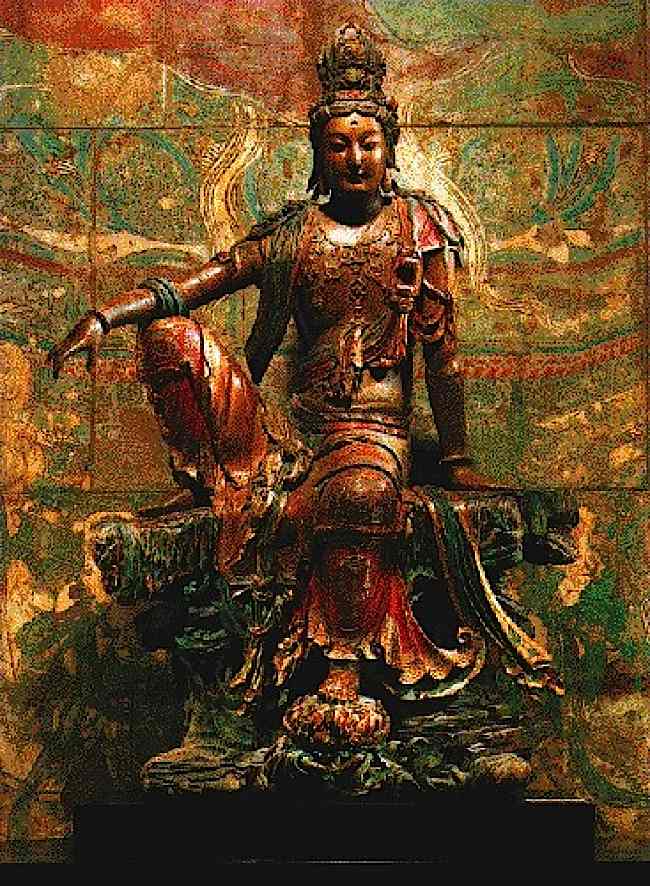
Guanyin, the Chinese female aspect of Avalokitesvara, Buddha of Compassion.
Where is Guanyin?
Venerable Master Hsuan Hua explains Guanyin is in every heart, in every home. More specifically, the Venerable teacher describes where we can find the loving Bodhisattva:
“Well, then, where does he come from? He fills empty space and pervades the Dharma Realm; he is in every place and yet not in any place. He appears according to what kind of body is needed to save each particular category of beings. He manifests in whatever physical form is appropriate to speak Dharma for beings; thus his identity is flexible. Guanshiyin Bodhisattva appears in the form of a Buddha to save those who are ready to become Buddhas. He appears as a Bodhisattva to save those who should become Bodhisattvas. He appears as a heavenly king to speak Dharma for beings in the heavens.”[5]

An image of Guanshiyin in the clouds.
The Saviour Buddha
In the Lotus Sutra, the merits of Avalokiteshvara are described in great detail, every possible danger listed, and how the Bodhisattva can save us. It is summarized in verse:
Perceiver of the World’s Sounds, pure sage—
to those in suffering, in danger of death,
He can offer aid and support.
Endowed with all benefits,
He views living beings with compassionate eyes.
The sea of his accumulated blessings is immeasurable;
therefore you should bow your head to him!

Kuan Yin in the clouds.
How to Ask for Guanyin’s Help
Thich Nhat Hanh explains how to awaken the energy of Avaolokiteshvara:
“Calling the name of Avalokiteshvara is one of the ways to awaken the energy of compassion in your heart.”
In the Lotus Sutra, Shakyamuni Buddha describes how to invoke the aid of the Compassionate Bodhisattva:
‘Hail to the Bodhisattva Perceiver of the World’s Sounds!’ And because they call his name, they are at once able to gain deliverance.
It’s literally that simple.
Namo Guan Shi Yin Pu Sa Chanting
Practices for Guanyin
A Devotee of Guanyin will always say prayers — and ideally make offerings (at least water) — morning and evening. On the 1st and 15th of the lunar month, the Sacred Days of Guanyin, it is auspicious to do additional mantras, prayers, and purifications.
Ideally set up a small altar at home with a photo, picture or nice statue. It is traditional to “invite” the Goddess into the statue.
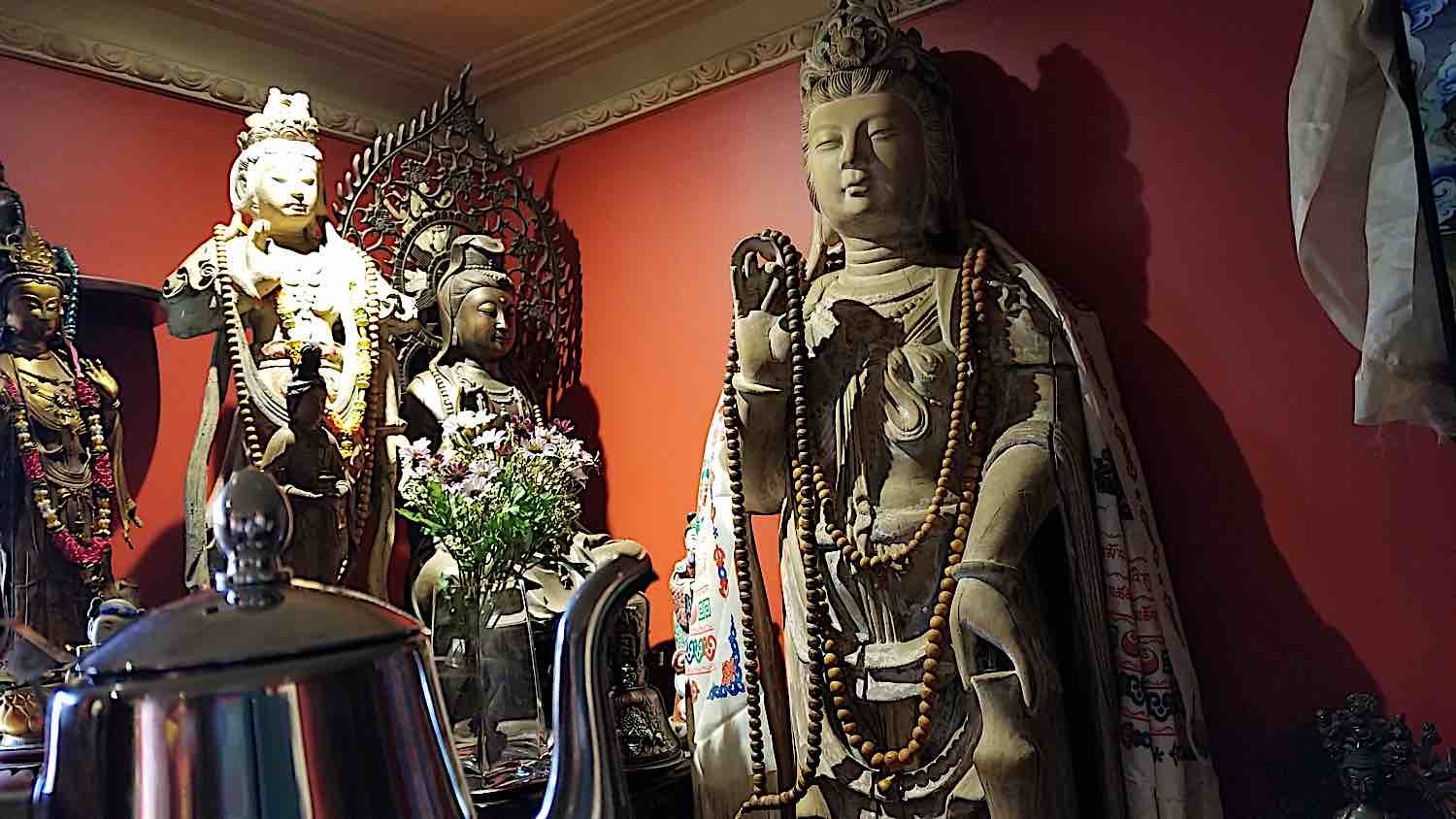
Making a tea offering to Guanyin.
Traditionally, you’d set up the statue, bow three times and ideally:
- Namo Guan Shi Yin Pu Sa (at least 3 times with bows)
- Take Refuge: “I take Refuge in the Buddha, the Dharma and the Sangha until I reach Enlightenment for the benefit of all sentient beings” — no practice is complete without taking Refuge first, and ending with Dedicating the Merit (see below.
- Light incense and place in front of statue.
- Present other offerings such as water bowls (at least 3 or 7), fruit, flowers and tea. (For symbolism, you could always use Tie Guan Yin tea, a famous type of tea, but Red Rose or any tea is fine.)
- Invite the presence of Guan Yin: ““I sincerely invite the Greatly Merciful and Greatly Compassionate Guan Yin Bodhisattva to perform miracles, and enter the sacred <statue or image> offered by me, <your full name>” [6]
- Peform at least 7 Great Compassion Mantra. You will find a chant-along video with Ani Choying below.
- Perform the Heart Sutra 7 times (it’s quite short.) You’ll find an AMAZING chant-along version with video with Dzongsar Khyentse Rinpoche and his sangha here>>
- Om Mani Padme Hum mantra as much as you can — at least 108 times. A version with Yoko Dharma in video is below.
- Prayers
- Dedicate the Merit for the benefit of all Sentient Beings: “I dedicate the merit of this practice for the cause for Enlightenment for the benefit of all sentient beings.”
Thinking of Guanyin is Enough to Save Beings
In the Lotus Sutra, chapter 25, Buddha explains:
World-Honored One replete with wonderful features,
I now ask you once again
for what reason that Buddha’s son
is named Bodhisattva Perceiver of the World’s Sounds?
The honored One endowed with wonderful features
replied to Inexhaustible Intent in verse:
Listen to the actions of the Perceiver of Sounds,
how aptly he responds in various quarters.
His vast oath is deep as the ocean;
kalpas pass but it remains unfathomable.
He has attended many thousands and millions of Buddhas,
setting forth his great pure vow.
I will describe him in outline for you-
listen to his name, observe his body,
bear him in mind, not passing the time vainly,
for he can wipe out the pains of existence.
Suppose someone should conceive a wish to harm you,
should push you into a great pit of fire.
Think on the power of that Perceiver of Sounds
and the pit of fire will change into a pond!
If you should be cast adrift on the vast ocean,
menaced by dragons, fish and various demons,
think on the power of that Perceiver of Sounds
and the billows and waves cannot drown you!
Suppose you are on the peak of Mount Sumeru
and someone pushes you off.
Think on the power of that Perceiver of Sounds
and you will hang in midair like the sun!
Suppose you are pursued by evil men
who wish to throw you down from a diamond mountain.
Think on the power of that Perceiver of Sounds
and they cannot harm a hair of you!
Suppose you are surrounded by evil-hearted bandits,
each brandishing a knife to wound you.
Think on the power of that Perceiver of Sounds
and at once all will be swayed by compassion!
Suppose you encounter trouble with the king’s law,
face punishment, about to forfeit your life.
Think on the power of that Perceiver of Sounds
and the executioner’s sword will be broken to bits!
Suppose you are imprisoned in cangue and lock,
hands and feet bound by fetters and chains.
Think on the power of that Perceiver of Sounds
and they will fall off, leaving you free!
Suppose with curses and various poisonous herbs
someone should try to injure you.
Think on the power of that Perceiver of Sounds
and the injury will rebound upon the originator.
Suppose you encounter evil rakshasas,
poison dragons and various demons.
Think on the power of that Perceiver of Sounds
and then none of them will dare to harm you.
If evil beasts should encircle you,
their sharp fangs and claws inspiring terror,
think on the power of that Perceiver of sounds
and they will scamper away in boundless retreat.
If lizards, snakes, vipers, scorpions
threaten you with poison breath that sears like flame,
think on the power of that Perceiver of Sounds
and, hearing your voice, they will flee of themselves.
If clouds should bring thunder, and lightning strike,
if hail pelts or drenching rain comes down,
think on the power of that Perceiver of Sounds
and at that moment they will vanish away.
If living beings encounter weariness or peril,
immeasurable suffering pressing them down,
the power of the Perceiver of Sounds’ wonderful wisdom
can save them from the sufferings of the world.
He is endowed with transcendental powers
and widely practices the expedient means of wisdom.
Throughout the lands in the ten directions
there is no region where he does not manifest himself.
In many different kinds of evil circumstances,
in the realms of hell, hungry spirits or beasts,
the sufferings of birth, old age, sickness and death–
all these he bit by bit wipes out.
He of the true gaze, the pure gaze,
the gaze of great and encompassing wisdom,
the gaze of pity, the gaze of compassion–
constantly we implore him, constantly look up in reverence.
His pure light, free of blemish,
is a sun of wisdom dispelling all darknesses.
He can quell the wind and fire of misfortune
and everywhere bring light to the world.
The precepts from his compassionate body shake us
like thunder,
the wonder of his pitying mind is like a great cloud.
He sends down the sweet dew, the Dharma rain,
to quench the flames of earthly desires.
When law suits bring you before the officials,
when terrified in the midst of an army,
think on the power of that Perceiver of Sounds
and hatred in all its forms will be dispelled.
Wonderful sound, Perceiver of the World’s Sounds,
Brahma’s sound, the sea tide sound–
they surpass those sounds of the world;
therefore you should constantly think on them
from thought to thought never entertaining doubt!
Perceiver of the World’s Sounds, pure sage–
to those in suffering, in danger of death,
he can offer aid and support.
Endowed with all benefits,
he views living beings with compassionate eyes.
The sea of his accumulated blessings is immeasurable;
therefore you should bow your head to him!
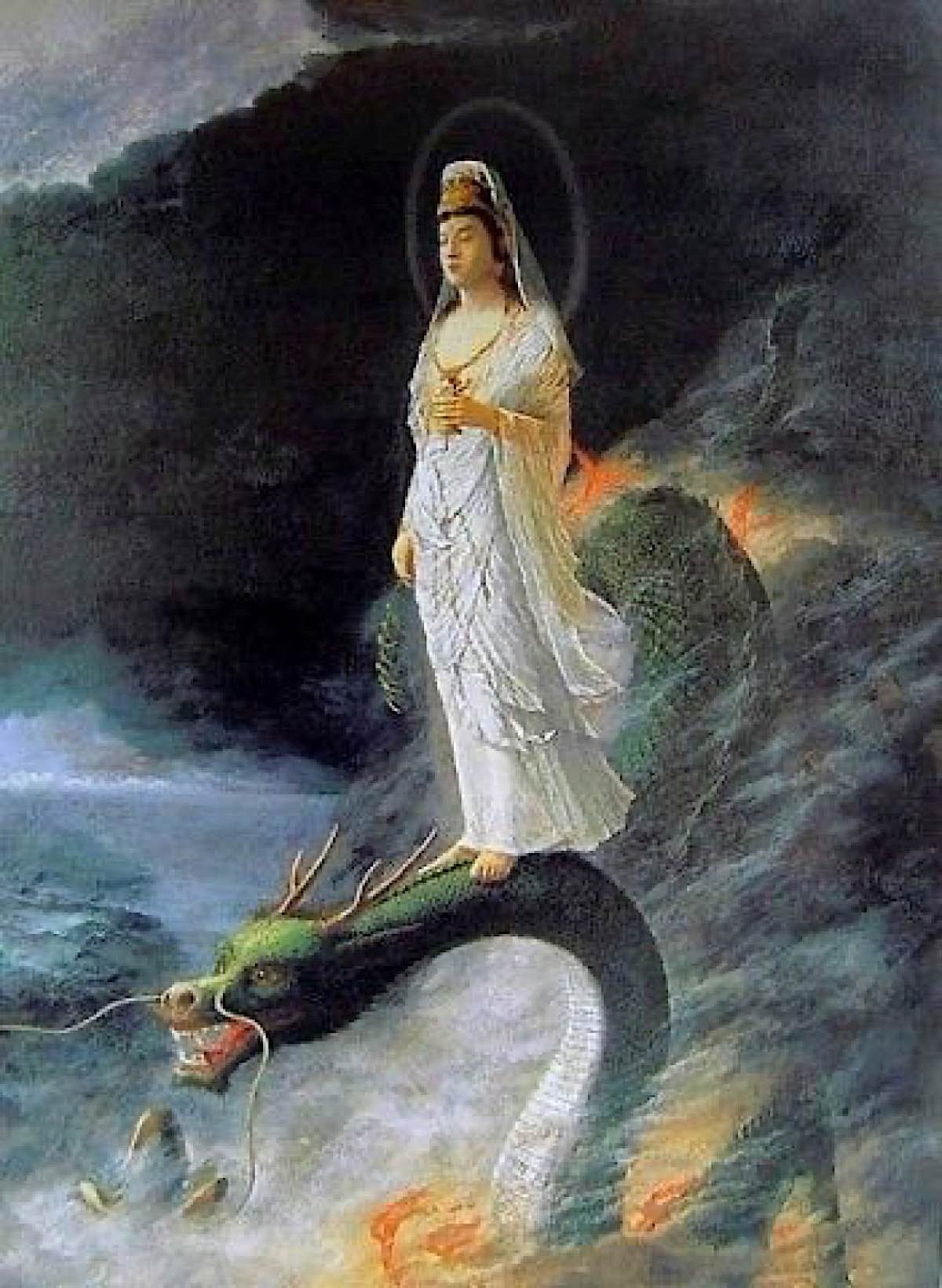
Guanyin on a dragon.
The Heart Sutra: Most Popular Sutra
Guanyin Avalokteshvara is mentioned in more Mahayana sutras than any other Enlightened Being.
The Heart Sutra is the “single most commonly recited, copied and studied scripture in East Asian Buddhism”[1] — Guanyin teaches the “Perfection of Wisdom”:
Form is Emptiness. Emptiness is Form
Emptiness, not to be confused with nothingness, is anchored in Buddha’s doctrine of Dependent Origination. The Heart Sutra is a profound teaching that frees us from fear and helps us understand the inter-connectedness of all beings.
The great Andy Lau (actor and singer) sings the Heart Sutra:
Guanyin Avalokiteshvara is especially praised in The Lotus Sūtra (Sanskrit Saddharma Puṇḍarīka Sūtra), notably in the 25th Chapter. [See our feature Avalokiteshvara: delivering us from every danger, Chapter 25 of Lotus Sutra.]

Statue of Guanyin.
Praise Loving Guanyin
Another way to ask for Guanshiyin’s help is simply to praise Her/His name. The various ways to praise His/Her name are:
Sanskrit
- Namo Avalokiteshvara
Various forms of Chinese (slight variants)
- Namo Gwan Yin Pu Sa
- Namo Kuanyin Pu Sa
- Namo Guan Yim
- Namo Kuan Yim
- Namo Kuan Yin
Kanon in Todaiji Mon
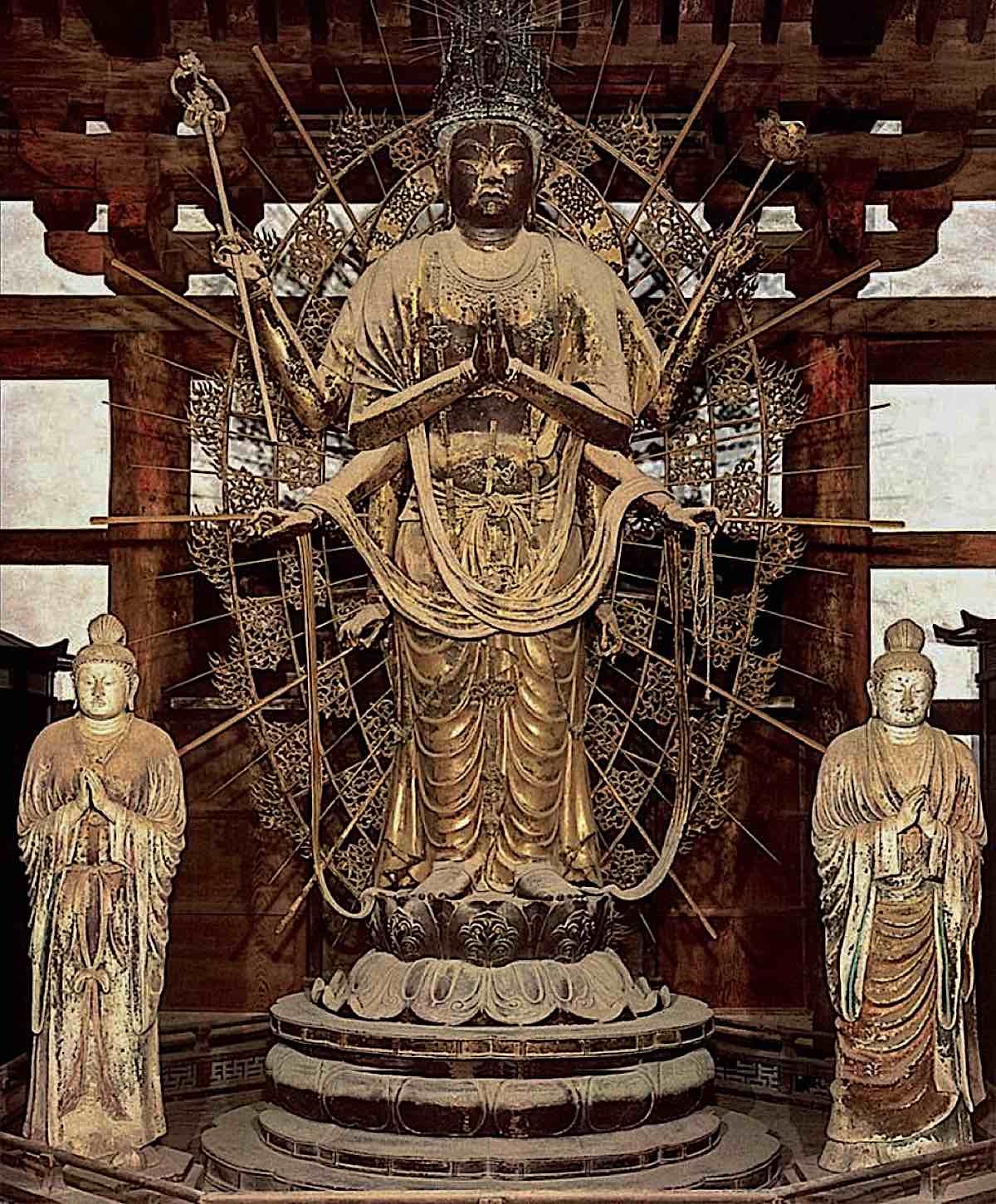
Kannon (Guanyin) in Todaiji Monastery Fukukensaku.
Other variants (Namo in all cases here is Sanskrit for simplicity)
- Namo Chenrezig (Chenrezik Tibetan སྤྱན་རས་གཟིགས)
- Namo Gwan-eum (Korean: 관세음)
- Namo Kanzeon (観世音) or Namo Kannon (観音) (Japanese)
- Namo Kuan Im (Thai กวนอิม)
- Namo Quán Thế Âm (Vietnamese)
- Namo to the Bodhisattva Perceiver of the World’s Sounds! (English)
Mantras of Avalokiteshvara
- Om Mani Padme Hum (Universal in Sanskrit)
[For a video chant of Om Mani Padme Hum see>>] Or watch here:
Yoko Dharma chants Om Mani Padme Hum
- On aruri kya sowa ka (Shingon) in Japanese おん あるりきゃ そわか
Great Compassion Mantra (Dharani) in Sanskrit
Namo Ratna Trayaya
Nama Arya Jyana
Sagara Vairochana
Byuhara Jaya Tathagataya
Arahate Samyaksam Buddhaya
Namah Sarwa Tathagate Bhyayh Arahatda Bhayh
Samyaksam Buddhe Bhayh
Namah Arya Awalokite
Shoraya Bohisatwaya
Mahasatwaya
Maha Karunikaya
Tatyata Om Dhara Dhara
Dhiri Dhiri
Dhuru Dhuru
Iti Wit Je Chalee Chalee
Purachale Purachale
Kusume Kusama Wa Re
Ili Mili Chiti
Jwala Mapanaya Soha
[For video chant version of the Great Compassion Mantra, see>>]
Any Choying sings the Great Compassion Mantra
Guanyin’s Special Day
Each year, Guanyin’s compassionate activities are celebrated on the 19th day of the 6th Lunar month — traditionally the anniversary of the day Guan Shi Yin attained Buddhahood (Enlightenment.) [4]
Her sacred place is Mount Puo Tu [普陀山].
Other Sutras with Avalokiteshvara
Although the Lotus Sutra is the first and best-known sutra honoring the compassionate Buddha, there are many others, including, of course, the Heart Sutras where he teaches his realizations on Shunyata (Emptiness). Some texts which mention Avalokiteśvara include:
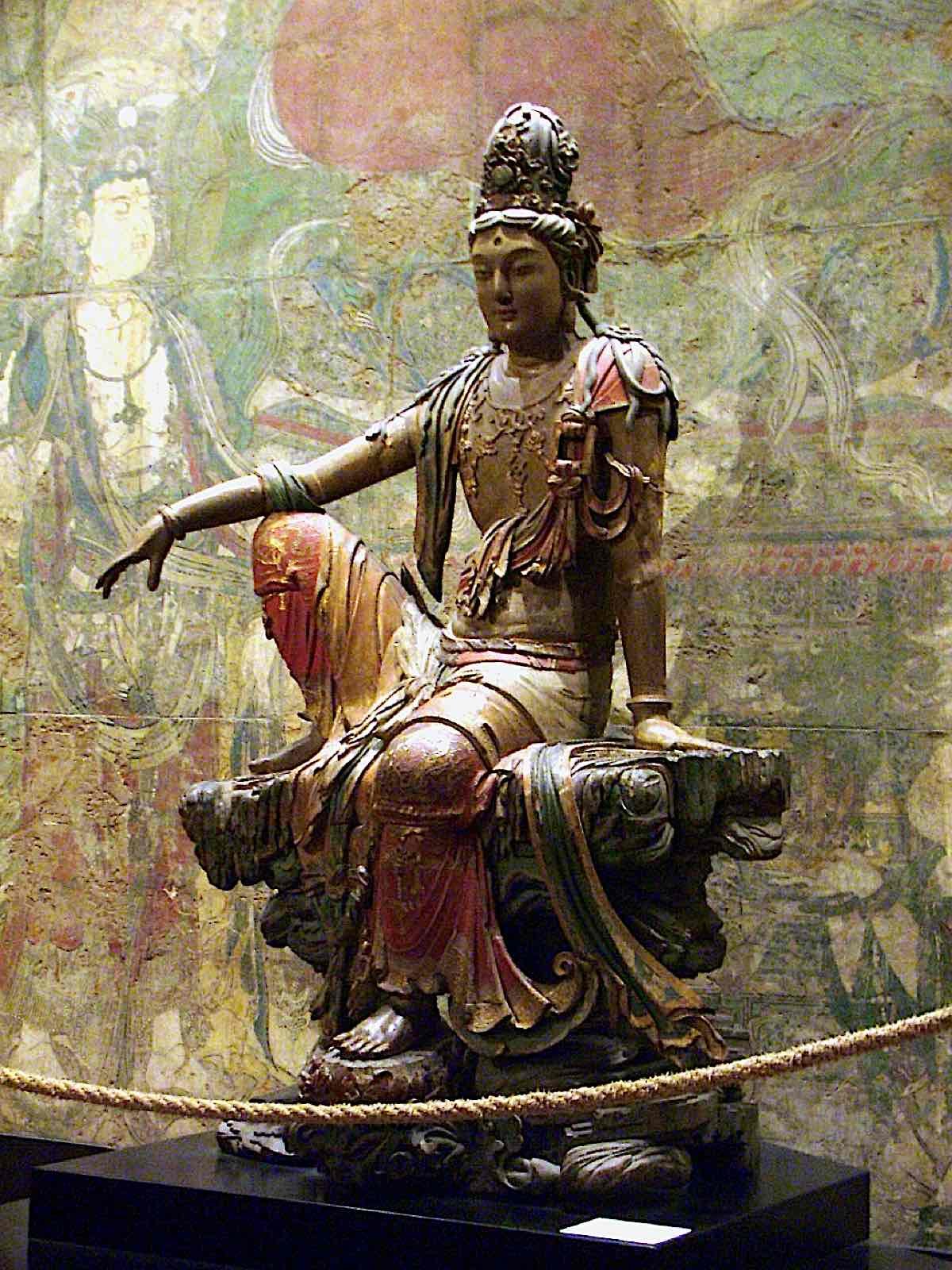
Kuanyin Liao Dynasty Avalokeshvara statue.
Other names of Guanyin Avalokteshvara
Avalokteshvara Guanyin is called by many names in different countries:
- Cantonese: Gwun Yam or Gun Yam also written as Kwun Yam in Hong Kong or Kun Iam in Macau.
- Tibetan: Chenrézik (སྤྱན་རས་གཟིགས).
- Japanese, Guanyin is pronounced Kannon (観音), occasionally Kan’on, or more formally Kanzeon (観世音, the same characters as Guanshiyin)
- Korean, Guanyin is called Gwan-eum (Korean: 관음) or Gwanse-eum (Korean: 관세음)
- Hokkien: Kuan Im (POJ: Koan-im) or Kuan Se Im (POJ: Koan-sè-im)
- Khmer: Preah Mae Kun Si Im. (ព្រះម៉ែ គង់សុីអុិម). She is also called Preah Neang Kun Si Im (ព្រះនាង[princess] គង់សុីអុិម). The word “Preah” is God/Goddess and “Mae” is Mother
- Thai: Kuan Im (กวนอิม), Phra Mae Kuan Im (พระแม่กวนอิม; Phra Mae means “goddess”) or Chao Mae Kuan Im (Thai: เจ้าแม่กวนอิม; Chao Mae usually means “madam”, but in this terms, means “goddess”).
- Burmese: Kwan Yin Medaw, literally meaning Mother Kwan Yin (Goddess Guanyin) (ကွမ်ယင်မယ်တော်).
- Vietnamese: Quan Âm or Quan Thế Âm.
- Indonesian: is Kwan Im or Dewi Kwan Im. She is also called Mak Kwan Im “Mother Guanyin”.
- Malaysian Mandarin: GuanYin Pusa (GuanYin Bodhisattva), Guan Shi Yin Pusa (GuanYin Bodhisattva).
- Sinhala: Natha Deviyo (නාථ දෙවියෝ).
- Hmong, the name is Kab Yeeb.
- Nepali, the name is Seto Machindranath

Avalokiteshvara as the wonderful goddess Guanyin.
NOTES
[1] McRae, John (2004), “Heart Sutra”, in Buswell, Jr., Robert E. (ed.), Encyclopedia of Buddhism, MacMillan
[2] Avalokteshvara feature on Britannica. https://global.britannica.com/topic/bodhisattva
[3] “Avalokiteshvara in Tibet”, Tricycle
[4] “Bodhisattva Guan Shi Yin’s Attainment of Buddhahood 觀世音菩薩成佛 – Purple Cloud”.
[5] Guanyin, Guanyin, Guanshiyin: Venerable Master Hsuan Hua http://www.cttbusa.org/dharmatalks/guanyin.htm

